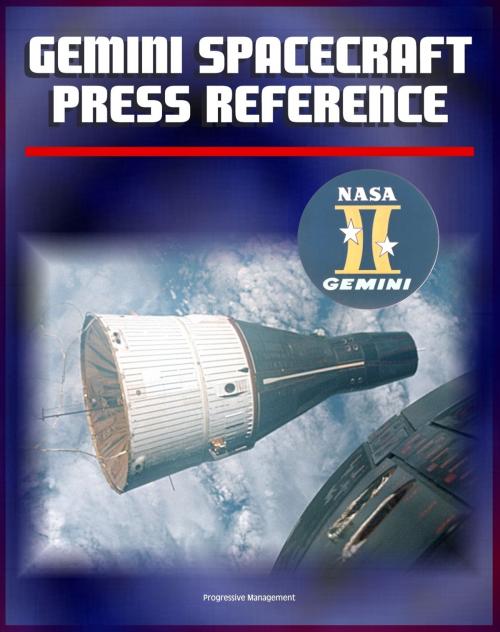Gemini Spacecraft Press Reference Book: Comprehensive Information on All Aspects of America's Two-Man Orbiting Spacecraft, Agena Docking Target, Systems
Nonfiction, Science & Nature, Science, Physics, Astrophysics & Space Science, History, Americas| Author: | Progressive Management | ISBN: | 9781465795373 |
| Publisher: | Progressive Management | Publication: | February 1, 2012 |
| Imprint: | Smashwords Edition | Language: | English |
| Author: | Progressive Management |
| ISBN: | 9781465795373 |
| Publisher: | Progressive Management |
| Publication: | February 1, 2012 |
| Imprint: | Smashwords Edition |
| Language: | English |
This official NASA history document - converted for accurate flowing-text e-book format reproduction - is the Gemini spacecraft press reference book, providing comprehensive information on all aspects of America's second manned spacecraft program which paved the way for the success of the Apollo lunar landing missions by demonstrating rendezvous, docking, EVA, and long-duration capabilities.
Contents include: Gemini Spacecraft Structural Description * Communication And Tracking System * Electrical System * Environmental Control System * Guidance And Control * Instrumentation And Recording * Orbit Attitude And Maneuver System (OAMS) * Agena Target Vehicle * Landing System * Experiment Provisions * Spacecraft Fabrication * History of Mercury and Gemini Programs * Glossary * much more.
The Gemini Spacecraft is a conical structure nearly 19 feet (5.80 meters) high, 10 feet (3.05 meters) in diameter at its base and weighing 8360 pounds (3792 kilograms) at launch.
The spacecraft is designed to endure the aerodynamic pressures, temperature loading, vibration and acoustical noise of launch; the temperature and vacuum of orbital flight; and the extreme heat of reentry, and the impact forces of water landing while providing life support for two astronauts and the necessary equipment for planned missions and experiments.
Gemini's design reflects the knowledge obtained from the development, manufacture and flight operation of the Mercury Spacecraft which, like Gemini, was produced for NASA by McDonnell Aircraft Corporation, St. Louis, Missouri.
Gemini is launched by an Air Force Titan II launch vehicle built by the Martin Company. The spacecraft consists of two major parts, a reentry module and an adapter module. The reentry module is designed to withstand the extreme heat of reentry. The dark color of the reentry module is characteristic of paints and coatings used to provide heat protection. The white exterior of the adapter module provides for maximum release of the heat brought to the metal surface by the spacecraft coolant lines. Its side walls are protected by heat resistant shingles and the large bulkhead by an ablative heat shield. The spacecraft is primarily "skin-stringer" construction. Ring stabilized stringers carry nearly all axial loads. Structural materials and construction methods exhibit the influence of Gemini engineers' search for optimum strength-to-weight ratios. Titanium and magnesium are the principal metals used.
This official NASA history document - converted for accurate flowing-text e-book format reproduction - is the Gemini spacecraft press reference book, providing comprehensive information on all aspects of America's second manned spacecraft program which paved the way for the success of the Apollo lunar landing missions by demonstrating rendezvous, docking, EVA, and long-duration capabilities.
Contents include: Gemini Spacecraft Structural Description * Communication And Tracking System * Electrical System * Environmental Control System * Guidance And Control * Instrumentation And Recording * Orbit Attitude And Maneuver System (OAMS) * Agena Target Vehicle * Landing System * Experiment Provisions * Spacecraft Fabrication * History of Mercury and Gemini Programs * Glossary * much more.
The Gemini Spacecraft is a conical structure nearly 19 feet (5.80 meters) high, 10 feet (3.05 meters) in diameter at its base and weighing 8360 pounds (3792 kilograms) at launch.
The spacecraft is designed to endure the aerodynamic pressures, temperature loading, vibration and acoustical noise of launch; the temperature and vacuum of orbital flight; and the extreme heat of reentry, and the impact forces of water landing while providing life support for two astronauts and the necessary equipment for planned missions and experiments.
Gemini's design reflects the knowledge obtained from the development, manufacture and flight operation of the Mercury Spacecraft which, like Gemini, was produced for NASA by McDonnell Aircraft Corporation, St. Louis, Missouri.
Gemini is launched by an Air Force Titan II launch vehicle built by the Martin Company. The spacecraft consists of two major parts, a reentry module and an adapter module. The reentry module is designed to withstand the extreme heat of reentry. The dark color of the reentry module is characteristic of paints and coatings used to provide heat protection. The white exterior of the adapter module provides for maximum release of the heat brought to the metal surface by the spacecraft coolant lines. Its side walls are protected by heat resistant shingles and the large bulkhead by an ablative heat shield. The spacecraft is primarily "skin-stringer" construction. Ring stabilized stringers carry nearly all axial loads. Structural materials and construction methods exhibit the influence of Gemini engineers' search for optimum strength-to-weight ratios. Titanium and magnesium are the principal metals used.















